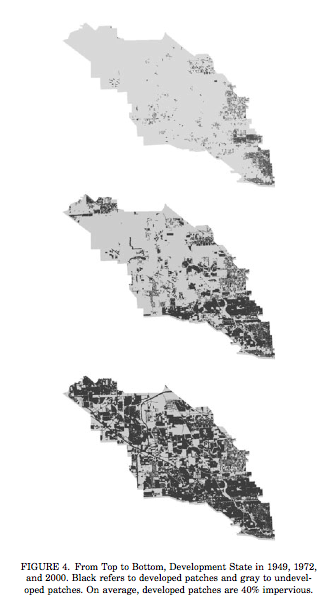Olivera, Francisco, and Buren B. DeFee. "Urbanization and Its Effect On Runoff in the Whiteoak Bayou Watershed, Texas1." JAWRA Journal of the American Water Resources Association 43.1 (2007): 170-82. Print.
The study, “Urbanization and its
effect on runoff in the Whiteoak Bayou Watershed, Texas”, by Francisco Olivera
and Buren B. DeFee studies the ability of a watershed to urbanize without
changing its “hydrologic response”. This question is extremely important to
take into account as development projects sprout up around the world; development means the
creation of more impervious areas (such as roads and parking lots) where water
can not soak into the ground. If the hydrologic response of a watershed is
altered too much, local ecosystems could face degradation, and flooding could
become a more serious problem.
The study compared precipitation,
water flow and land development data for the Whiteoak Bayou watershed in the 52
years from 1949 to 2000. Using GIS, the study analyzed the effect development
had on runoff. Once data was found, 52 maps were created depicting the
development on the watershed for each year, the maps were put in a GIS and
converted to raster format, dark pixels representing developed land and white
pixels representing undeveloped land. The data shows that until the early 70’s
the Whiteoak watershed was able to continue drainage at normal amounts. In the
early 70’s the watershed was covered in 10% impervious area; once it past that
10% coverage, changes occurred to the watershed. Since then annual runoff
depths have increased by 146% and peak flows in the mouth of the Bayou have
increased by 159%. As the runoff and peak flow have increased over the years,
so too has precipitation, but, precipitation has increased at much lower rates
than runoff and peak flow, accounting for 39% of the increase in runoff and 96%
of the increased peak flow. This means that urbanization is accountable for 77%
increase of runoff water and 32% increase of peak flow in the mouth of the Bayou.
The study concludes that
urbanization can affect the hydrologic responses of watersheds when development
passes the point in which the watershed can no longer handle urbanization. For
this specific watershed that point was 10% impervious cover, but the study
points out that different types of development can have different responses, so further study will be needed for other urban areas.



This is interesting to me because in my Independent Study we discussed the impact of impervious cover on the habitat of the Georgetown Salamander. Urbanization is the salamander's greatest threat and impervious cover is a main component of that threat because it decreases recharge of groundwater which the species depends on. Also, increased runoff due to impervious cover can mean more sedimentation, contamination, decreased vegetative diversity and reduced visibility of the above surface portion of their habitat. This is a interesting study, and it would be cool to do something similar but also take into account layers of habitat and runoff quantity to get a better idea of the impact of impervious cover on particular species.
ReplyDelete